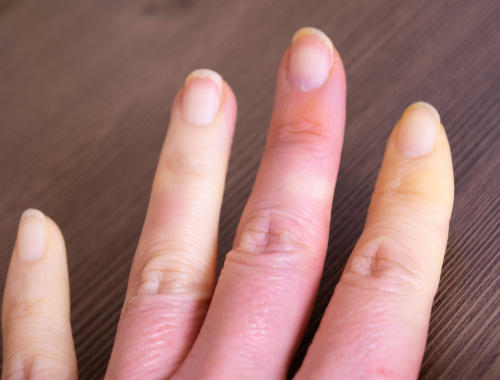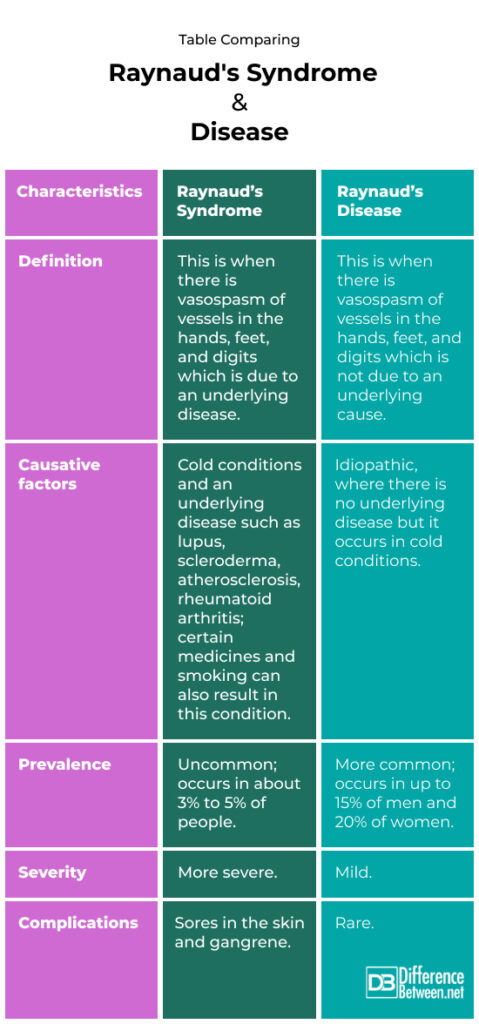Difference Between Raynaud’s Syndrome and Disease
Raynaud’s syndrome is a disorder involving spasm of the blood vessels in an extremity that is not due to an underlying condition. Raynaud’s disease is a spasm of the blood vessels, which is due to having an underlying illness.

What is Raynaud’s Syndrome?
Definition:
Raynaud’s syndrome is where blood vessels of the distal extremities, particularly the toes and fingers, constrict; it is also known as secondary Raynaud’s disease as it is associated with some disorder or underlying illness.
Causes and prevalence:
Individuals with the following conditions can develop Raynaud’s syndrome: atherosclerosis, rheumatoid arthritis, or lupus. Smoking and taking beta-blocker medications can also lead to the problem. Raynaud’s syndrome occurs in about 3% to 5% of people.
Symptoms and complications:
The symptoms include the hand or parts of the hand feeling cold and numb. The skin of the affected area either turns blue or white and the area is painful. Usually only one side of the body is affected. Complications can occur, with extremities ulcerating and becoming gangrenous.
Diagnosis:
The symptoms and tests such as tests of capillary refill time can help with diagnosis. Blood tests are also often used to diagnose Raynaud’s syndrome. These tests include the following measuring C-reactive protein and erythrocyte sedimentation rate (ESR). Digital pulse wave tests are done which measure how stiff the arteries are. Other tests that may be done include blood tests looking for rheumatoid factor and anti-nuclear antibodies.
Treatment:
The treatment will often target the underlying disease or condition. Treatment may include giving intravenous prostaglandins, or using antibiotics and analgesics. Calcium-channel blockers are often given to patients with Raynaud’s syndrome since these are vasodilators that widen blood vessels.

What is Raynaud’s disease?
Definition:
This is known as primary Raynaud’s disease and is the illness that occurs without another illness as a causative factor.
Causes and prevalence:
Raynaud’s disease can happen when temperatures are very low or when the person has emotional stress. It occurs in about 20% of women and 15% of men, and it happens most often in early adulthood (people who are in their 20s or 30s).
Symptoms and complications:
The hands, feet, toes, and fingers turn white or blue when it is cold, and may feel numb and sore. The affected areas are symmetrical, e.g., on both the left and right hand. There is a low risk of complications.
Diagnosis:
Diagnosis is by the physical signs and tests such as the capillary refill test and other blood tests.
Treatment:
Treatment of primary Raynaud’s includes lifestyle changes such as keeping your hands and feet warm and avoiding exposing your body to cold conditions. Calcium channel blockers, such as nifedipine, are given to help improve blood flow by helping to reverse the vasospasm of the blood vessels.
Difference betweenRaynaud’s syndrome and Disease?
Definition
Raynaud’s syndrome is when there is vasospasm of vessels in the hands, feet, and digits which is due to an underlying disease. Raynaud’s disease is when there is vasospasm of vessels in the hands, feet, and digits that is not due to an underlying disease
Causative factors
Cold conditions and an underlying disease such as lupus, scleroderma, atherosclerosis, rheumatoid arthritis; certain medicines and smoking can result in Raynaud’s syndrome. Raynaud’s disease is idiopathic, it is not caused by an underlying problem.
Prevalence
Raynaud’s syndrome is rare occurring in 3% to 5% of people. Raynaud’s disease is more common occurring in about 15% of men and 20% of women.
Severity
Raynaud’s syndrome is a more severe condition while Raynaud’s disease is often mild.
Complications
Potential complications of Raynaud’s syndrome include ulcer formation and gangrene. Raynaud’s disease very rarely has any complications.
Table comparing Raynaud’s syndrome and Disease

Summary of Raynaud’s syndrome Vs. Disease
- Raynaud’s syndrome is a result of another problem while Raynaud’s disease is idiopathic.
- In all cases, Raynaud’s causes the fingers and toes to turn white and go numb when it is cold.
FAQ
Is Raynaud’s an autoimmune disease or disorder?
Some forms of the condition may be linked in some way to an autoimmune disease such as lupus.
How to differentiate Buerger’s disease from Raynaud’s disease?
In Raynaud’s disease the fingers or toes may turn white while in Buerger’s disease there is often ulceration of the digits.
Is Raynaud’s syndrome the same as Raynaud’s disease?
The term Raynaud’s syndrome is used to refer to secondary Raynaud’s while Raynaud’s disease refers to primary Raynaud’s, but symptoms are similar for both conditions.
Is Raynaud’s disease related to MS?
The disease may be related to MS since some patients who are later diagnosed with MS have had Raynaud’s disease.
What happens if Raynaud’s goes untreated?
If you have severe Raynaud’s syndrome and do not get treated, then there is a risk of later developing ulcerations and gangrene in the digits.
What autoimmune disease causes Raynaud’s?
Diseases like rheumatoid arthritis, scleroderma, and lupus can result in Raynaud’s syndrome.
What is the life expectancy of someone with Raynaud’s syndrome?
The average life expectancy is 74.5 years for someone with Raynaud’s syndrome.
Low temperatures and stress can trigger Raynaud’s disease.
- Difference Between Rumination and Regurgitation - June 13, 2024
- Difference Between Pyelectasis and Hydronephrosis - June 4, 2024
- Difference Between Cellulitis and Erysipelas - June 1, 2024
Search DifferenceBetween.net :
Leave a Response
References :
[0]Teo, Koon K. “Raynaud syndrome.” Merckmanuals. Merck & Co., 2022, https://www.msdmanuals.com/professional/cardiovascular-disorders/peripheral-arterial-disorders/raynaud-syndrome
[1]Temprano, Katherine K. "A review of Raynaud’s disease." Missouri medicine 113.2 (2016): 123.
[2]Wright, Sarah EV, et al. "E25. Unilateral Raynaud’s Phenomenon as the Presenting Feature of Multiple Sclerosis." Rheumatology 54. suppl_1 (2015): i182-i182.
[3]Image credit: https://www.canva.com/photos/MAE9oKz8H8U-man-showing-hands-with-raynaud-syndrome-raynaud-s-phenomenon-or-raynaud-s-disease/
[4]Image credit: https://www.canva.com/photos/MAE-uGYpBdU-fingers-discolored-with-raynaud-s-disease-symptoms/
